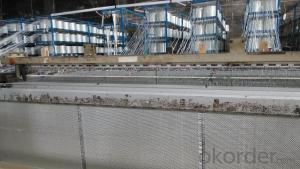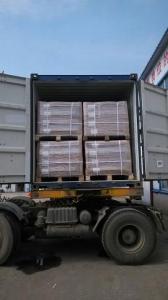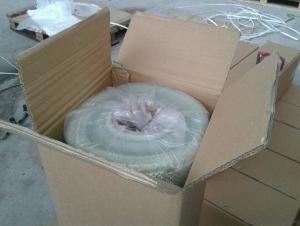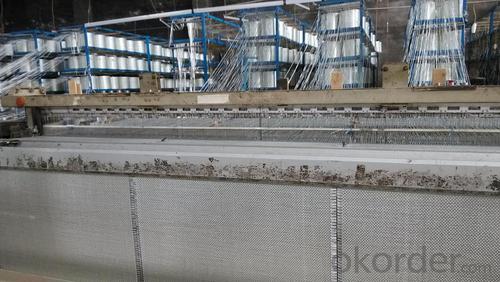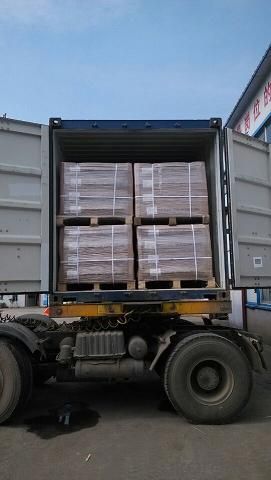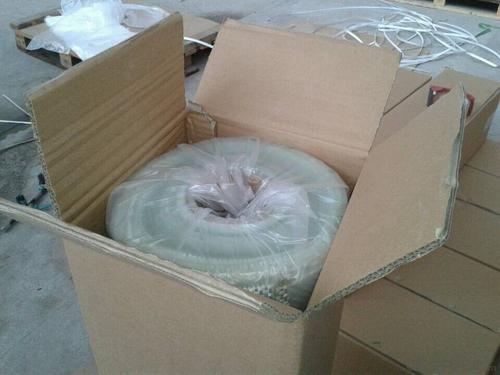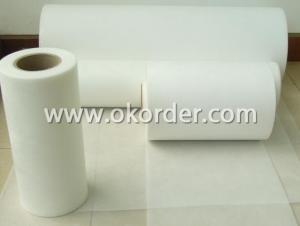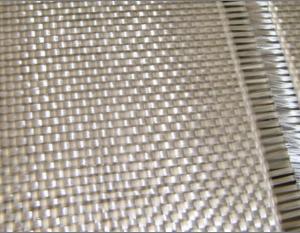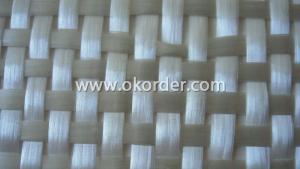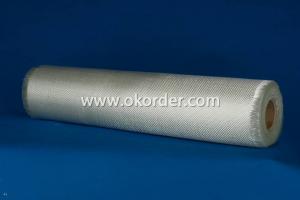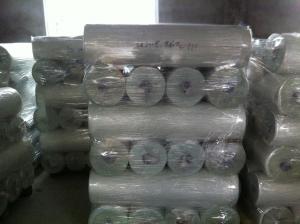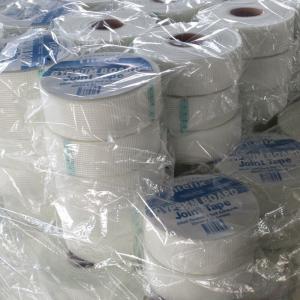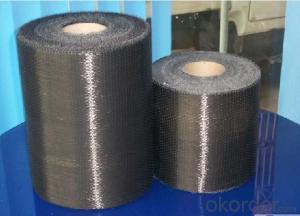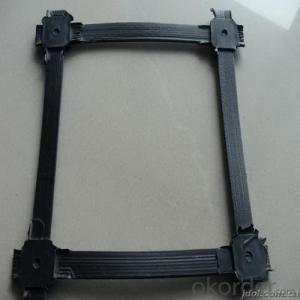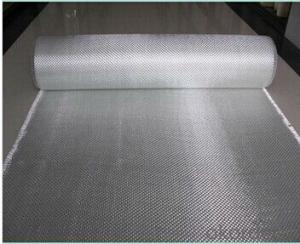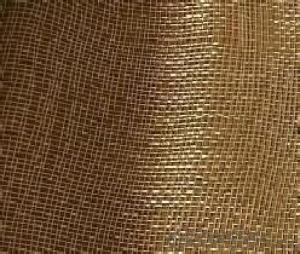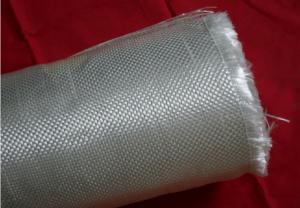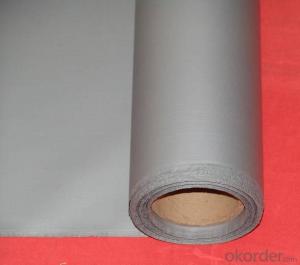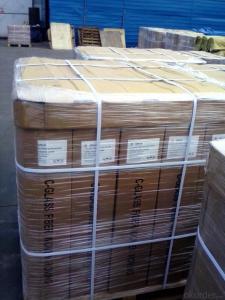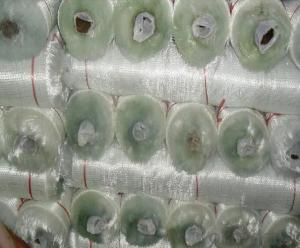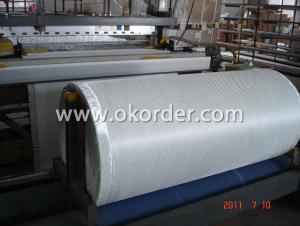Teflon Coated C Glass Fiber Woven Fabrics
- Loading Port:
- China Main Port
- Payment Terms:
- TT or LC
- Min Order Qty:
- 17600 kg
- Supply Capability:
- 176000Kg Per Month kg/month
OKorder Service Pledge
OKorder Financial Service
You Might Also Like
1.Brief Introduction
C Glass fabrics are bidirectional fabric made by interweaving direct rovings.
C Glass fabrics are compatible with unsaturated polyester, vinyl ester, epoxy and phenolic resins.
C Glass fabrics are a high performance reinforcement widely used in hand lay up and robot processes to manufacture boats, vessels, plane and automotive parts, furniture and sports facilities.
2.Product Features
Warp and weft rovings aligned in a parallel and flat manner, resulting in uniform tension
Densely aligned fibers, resulting in high dimensional stability and making handling easy
Good moldability, fast and complete wet out in resins, resulting in high productivity
Good mechanical properties and high strength of parts
3.Product Specifications
Property | Area Weight | Moisture Content | Size Content | Width |
(%) | (%) | (%) | (mm) | |
Test Method | IS03374 | ISO3344 | ISO1887 | |
CWR200 | ±7.5 | ≤0.15 | 0.4-0.8 | 20-3000 |
CWR270 | ||||
CWR300 | ||||
CWR360 | ||||
CWR400 | ||||
CWR500 | ||||
CWR600 | ||||
CWR800 |
Special specification can be produce according to customer requirements.
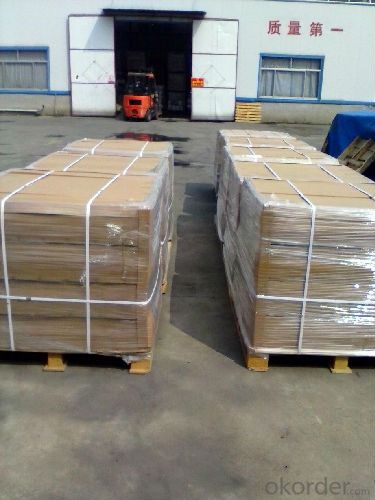
4.FAQ
Packaging:
Each woven roving is wound onto a paper tube which has an inside diameter of 76mm and the mat roll has a diameter of 220mm. The woven roving roll is wrapped up with plastic film,and then packed in a cardboard box or wrapped up with kraft paper. The rolls can be horizontally placed. For transportation, the rolls can be loaded into a cantainer directly or on pallets.
Storage:
Unless otherwise specified,It should be stored in a dry, cool and rain-proof area. It is recommended that the room temperature and humidity should be always maintained at 15℃~35℃ and 35%~65% respectively.
- Q: Can fiberglass fabrics be used for reinforcement in architectural structures?
- Indeed, architectural structures can benefit from the use of fiberglass fabrics for reinforcement. Fiberglass, known for its strength and lightweight nature, possesses exceptional resistance to corrosion and high tensile strength, rendering it an ideal choice for reinforcing various architectural elements. The construction industry often employs fiberglass to strengthen concrete structures like walls, beams, and columns. By embedding fiberglass fabrics into concrete, its durability and strength increase, offering additional support and minimizing the risk of cracks or structural failure. Moreover, fiberglass fabrics display flexibility, allowing easy molding and shaping to accommodate diverse architectural designs and structures. Ultimately, fiberglass fabrics prove to be a versatile and dependable option for reinforcing architectural structures.
- Q: Can fiberglass fabric be used for making tablecloths?
- Fiberglass fabric is not typically used for making tablecloths. This type of fabric is known for its durability, strength, and heat resistance, making it more suitable for applications such as insulation, construction materials, or protective clothing. Tablecloths, on the other hand, are typically made from fabrics that are soft, lightweight, and easy to clean, such as cotton, linen, polyester, or blends of these materials. These fabrics provide a comfortable and aesthetically pleasing surface for dining and are better suited for tablecloth purposes.
- Q: Can fiberglass fabrics be used for insulation in appliances?
- Yes, fiberglass fabrics can be used for insulation in appliances. Fiberglass fabrics are made from woven glass fibers that are highly heat-resistant and have excellent insulation properties. They can effectively trap and retain heat, making them ideal for insulating appliances such as ovens, stoves, and refrigerators. Additionally, fiberglass fabrics are lightweight, flexible, and easy to work with, allowing them to be easily installed in various appliance designs. They also have good durability and can withstand high temperatures without degrading or losing their insulation properties. Overall, fiberglass fabrics are a reliable and efficient choice for insulation in appliances.
- Q: How does fiberglass fabric perform in terms of dimensional stability?
- Fiberglass fabric exhibits excellent dimensional stability, making it highly reliable and suitable for a wide range of applications. Thanks to its unique composition of woven glass fibers, it possesses remarkable resistance to changes in shape or size, even under extreme temperature fluctuations or mechanical stress. This stability ensures that fiberglass fabric maintains its original dimensions and shape over time, allowing it to consistently meet the required specifications and performance criteria. Additionally, its dimensional stability makes fiberglass fabric ideal for applications where precise measurements and accuracy are necessary, such as in aerospace, automotive, and construction industries. Overall, fiberglass fabric's exceptional dimensional stability is one of its key attributes, contributing to its widespread use and popularity across various sectors.
- Q: Can fiberglass fabrics be used for reinforcement in 3D-printed objects?
- Yes, fiberglass fabrics can be used for reinforcement in 3D-printed objects. The fiberglass fabric can be embedded in the printing material to enhance the strength and durability of the finished object.
- Q: How does fiberglass fabric perform in high-humidity environments?
- Fiberglass fabric boasts exceptional performance in environments with high humidity. Its non-absorbent properties ensure it remains impervious to moisture and unaffected by water vapor in the air. As a result, even in high-humidity conditions, fiberglass fabric maintains its structural integrity, strength, and dimensional stability. Unlike certain materials that may warp, shrink, or become brittle in humid conditions, fiberglass fabric remains unaffected. Moreover, the non-porous nature of fiberglass fabric hinders the growth of mold, mildew, and other fungi that thrive in moist surroundings. This renders fiberglass fabric an excellent choice for various applications, including boat building, outdoor furniture, and construction projects in high-humidity areas. Overall, fiberglass fabric's resistance to moisture and its ability to withstand high-humidity environments establish it as a reliable and durable material in such conditions.
- Q: Mural and wallpaper are different, which should pay attention to choosing murals?
- Murals and wallpaper are two concepts, the murals are a custom-made pattern, according to the actual size of the wall made, and wallpaper is a regular pattern, so murals are usually used for local posting.
- Q: Is fiberglass fabric resistant to chemicals in industrial settings?
- In industrial settings, fiberglass fabric is generally resistant to chemicals. This fabric is made from fine glass fibers, which give it excellent resistance to a wide range of chemicals, including acids, alkalis, solvents, and oils. As a result, it is suitable for use in industries where workers come into contact with various chemicals, such as chemical processing, petrochemical, and pharmaceutical industries. Additionally, fiberglass fabric is well-known for its ability to withstand high temperatures and its flame retardant properties, making it even more suitable for industrial environments. However, it is important to note that the resistance of fiberglass fabric to chemicals may vary depending on the specific type and concentration of the chemical. Therefore, it is always recommended to consult the manufacturer's specifications or conduct compatibility tests before using fiberglass fabric in a particular industrial application.
- Q: Can fiberglass fabric be used for making soundproofing materials?
- Fiberglass fabric is capable of being utilized in the production of soundproofing materials. Its high density and capacity to absorb sound waves make it an exceptional material for sound insulation. When applied as a fabric, it can either be layered or wrapped around surfaces to effectively decrease noise transmission. In the construction industry, fiberglass fabric is frequently used to construct sound barriers in walls, ceilings, and floors. Moreover, it is employed in the automotive and aerospace sectors to minimize noise pollution. The fabric's ability to capture and absorb sound waves renders it an excellent choice for soundproofing materials. It is worth mentioning, however, that achieving optimal soundproofing outcomes may necessitate proper installation and the addition of supplementary layers.
- Q: What are the maintenance requirements of fiberglass fabric?
- The maintenance requirements of fiberglass fabric typically involve regular cleaning with mild soap and water, avoiding the use of harsh chemicals or abrasive cleaners that may damage the fabric. It is important to avoid excessive scrubbing or rubbing, as it may cause fraying or weakening of the fabric. Additionally, storing the fabric in a clean and dry environment when not in use can help prolong its lifespan.
Send your message to us
Teflon Coated C Glass Fiber Woven Fabrics
- Loading Port:
- China Main Port
- Payment Terms:
- TT or LC
- Min Order Qty:
- 17600 kg
- Supply Capability:
- 176000Kg Per Month kg/month
OKorder Service Pledge
OKorder Financial Service
Similar products
Hot products
Hot Searches
Related keywords
